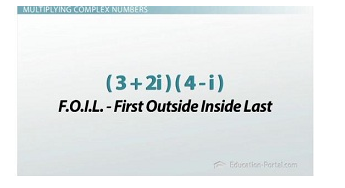Subtracting Complex Numbers
Subtraction is basically the same, but it does require you to be careful with your negative signs. Let's try the example (-2 + 4i) - (3 - i). Combining the real parts looks like -2 - 3=-5, while the negatives will make the imaginary parts a little bit trickier. The first imaginary term 4i minus the second one -i gives us 5i for our imaginary term. Remember that subtracting a negative turns into adding a positive. Therefore our answer is -5+5i.
If you prefer, the formula for subtraction of complex numbers looks like this: (a+bi) - (c+di)=(a - c)+(b - d)i
.
Multiplying Complex Numbers
On to multiplication. This will again rely upon an older skill, the multiplication of binomials. Whether you use FOIL, the area method, the distributive property or one of the other many ways to do it, this is the process of multiplying two terms like (x - 5)(x+2).
Now, though, we are simply doing the same thing, but with is instead of xs. Take (3+2i)(4 - i) as an example. I'll go ahead and use FOIL because it seems to be the most common method, but any way you would like to do this is totally fine.
Multiplying the first terms (3 * 4) gives us 12. The outsides will be 3 * -i, giving us -3i. The insides will be 2i * 4, which turns into 8i, and finally the last terms (2i * -i) becomes -2i^2.
We can then again use our combining-like-terms skills to simplify our expression down to 12+5i-2i^2. If you said you were done, you'd more or less be right, but you'd be forgetting one step that would prevent your answer from being completely simplified. This step requires you to remember that i^2 is just plain old -1! No more imaginary numbers. Substituting this in for i^2 into our expression and then again combining like terms gives us our final answer as 14+5i.

You can use the FOIL method to work out the problem.
Let's do one last example that ties all these skills together. Simplify (-7+14i) - (3+2i)(1+4i).
Order of operations tells us to do multiplication before subtraction, so we can FOIL out the first two complex numbers first. Multiplying the firsts, outsides, insides and lasts gives us (3+12i+2i+8i^2). In order to not forget, let's substitute -1 in for i^2 right away and then combine both the real and imaginary parts at once to give us -5+14i.
We can now move on to the subtraction part of this problem. It again comes down to just combining like terms. First, the real parts: (-7-(-5)). Again, subtracting a negative is just like adding a positive, so we just get -2. Then the imaginary parts: (14i - 14i) is just 0. That means our answer is simply -2!
This example illustrates why it's good to be able to use complex numbers. If you let yourself imagine that they exist, you might just end up with a number that truly does!
Lesson Summary
To review, adding and subtracting complex numbers is simply a matter of combining like terms. You combine the real and imaginary parts separately, and you can use the formulas if you like. Multiplying complex numbers is basically just a review of multiplying binomials. The only extra step at the end is to remember that i^2 equals -1. Dividing complex numbers, on the other hand, is a little more complicated and will be taught in a later lesson.